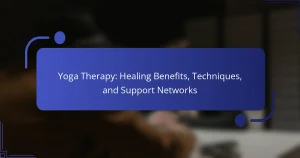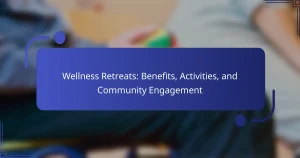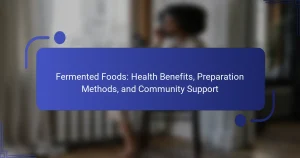Digital detox can significantly improve mental health by reducing anxiety and depression linked to digital overuse. This article explores effective strategies for implementing a digital detox, highlights community initiatives that foster support, and examines unique cultural approaches to disconnecting from technology. By understanding these aspects, individuals can enhance their well-being and build stronger social connections.
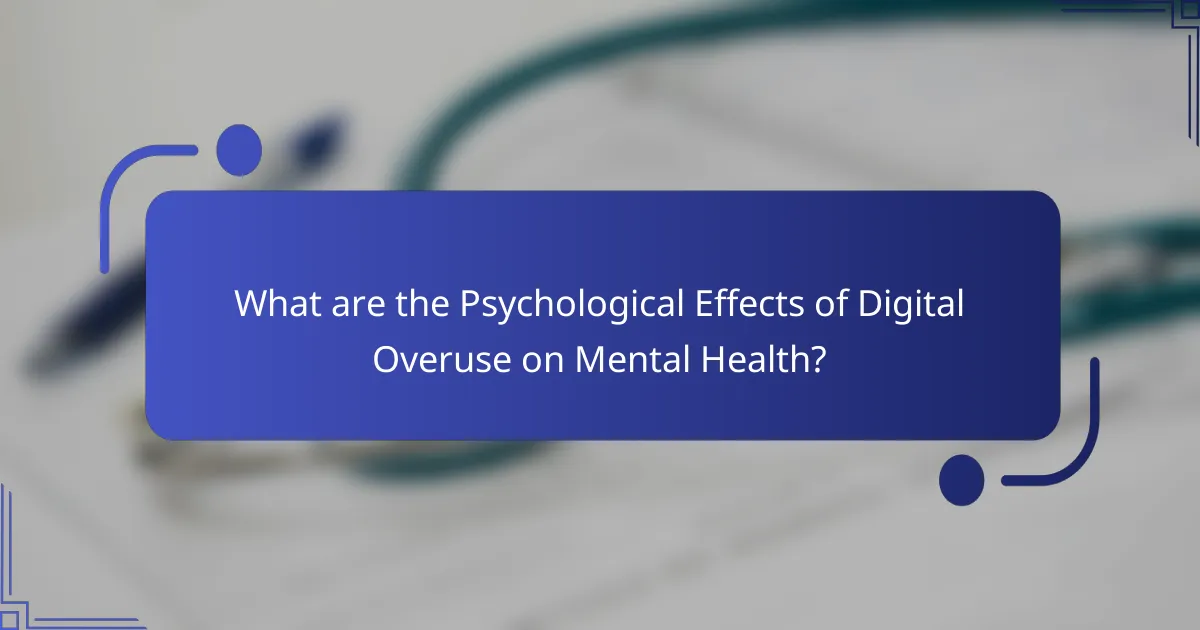
What are the Psychological Effects of Digital Overuse on Mental Health?
Digital overuse negatively impacts mental health, leading to anxiety, depression, and social isolation. A digital detox can mitigate these effects by reducing screen time and promoting mindfulness. Strategies include setting device-free times, engaging in outdoor activities, and fostering in-person connections. Community initiatives, such as workshops and support groups, encourage collective participation in digital detox efforts, enhancing social bonds and mental well-being.
How Does Screen Time Correlate with Anxiety and Depression?
Screen time is linked to increased anxiety and depression levels. Studies show that excessive screen use can lead to negative mental health outcomes. Digital detox initiatives encourage reduced screen time, promoting better emotional well-being. Community programs provide support and strategies for individuals seeking to disconnect and improve mental health.
Which Age Groups are Most Affected by Digital Overuse?
Young adults and teenagers are most affected by digital overuse, experiencing significant mental health challenges. Studies show that individuals aged 18-24 report higher anxiety and depression linked to excessive screen time. Children aged 8-12 also face risks, including attention issues and social isolation. As a result, targeted digital detox strategies are increasingly important for these age groups. Community initiatives promoting balanced technology use are essential to mitigate these impacts and foster healthier habits.
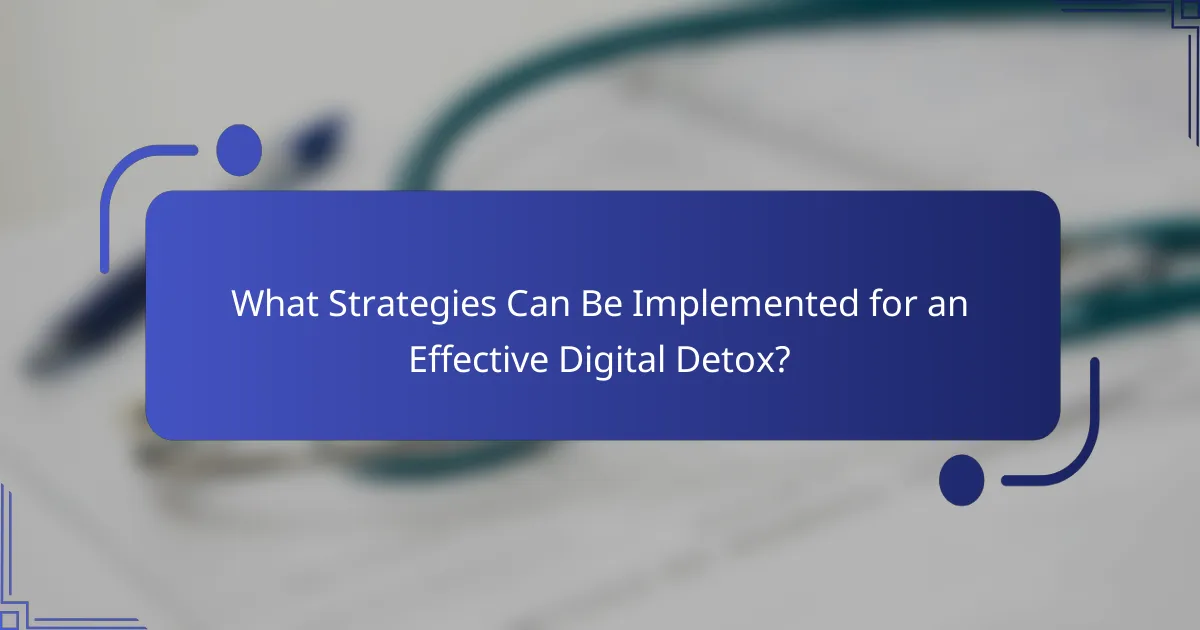
What Strategies Can Be Implemented for an Effective Digital Detox?
Implementing effective strategies for a digital detox involves setting clear boundaries, engaging in offline activities, and fostering community support. Prioritize designated tech-free times, such as during meals or before bed, to reduce screen dependency. Engage in hobbies like reading, exercising, or spending time in nature to fill the time previously spent online. Join community initiatives, such as local workshops or support groups, to share experiences and encourage accountability. These strategies can significantly enhance mental well-being by reducing stress and improving focus.
How to Create a Personalized Digital Detox Plan?
To create a personalized digital detox plan, assess your current digital habits and set specific goals. Begin by identifying the devices and platforms that consume most of your time. Next, establish boundaries, such as designated tech-free hours or areas. Incorporate activities that promote mental well-being, like reading or outdoor exercises. Finally, track your progress and adjust your plan as needed to maintain balance.
What Techniques Help in Reducing Screen Time Gradually?
Gradually reducing screen time can be achieved through several effective techniques. Start by setting specific limits on daily usage, gradually decreasing the time allowed. Implement scheduled breaks during screen activities to encourage physical movement and mental rest. Engage in alternative activities such as reading or outdoor exercises to replace screen time. Establish screen-free zones in your home to create a healthier environment. Lastly, track your progress to stay motivated and accountable.
Which Apps Support Digital Detox Efforts?
Several apps support digital detox efforts by promoting mindfulness and reducing screen time. Popular options include Forest, which encourages users to focus by growing virtual trees, and Moment, which tracks device usage. Other noteworthy apps are Stay Focused, designed to limit app usage, and Flipd, which provides a distraction-free mode. Each app offers unique features that help users regain control over their digital habits and improve mental well-being.
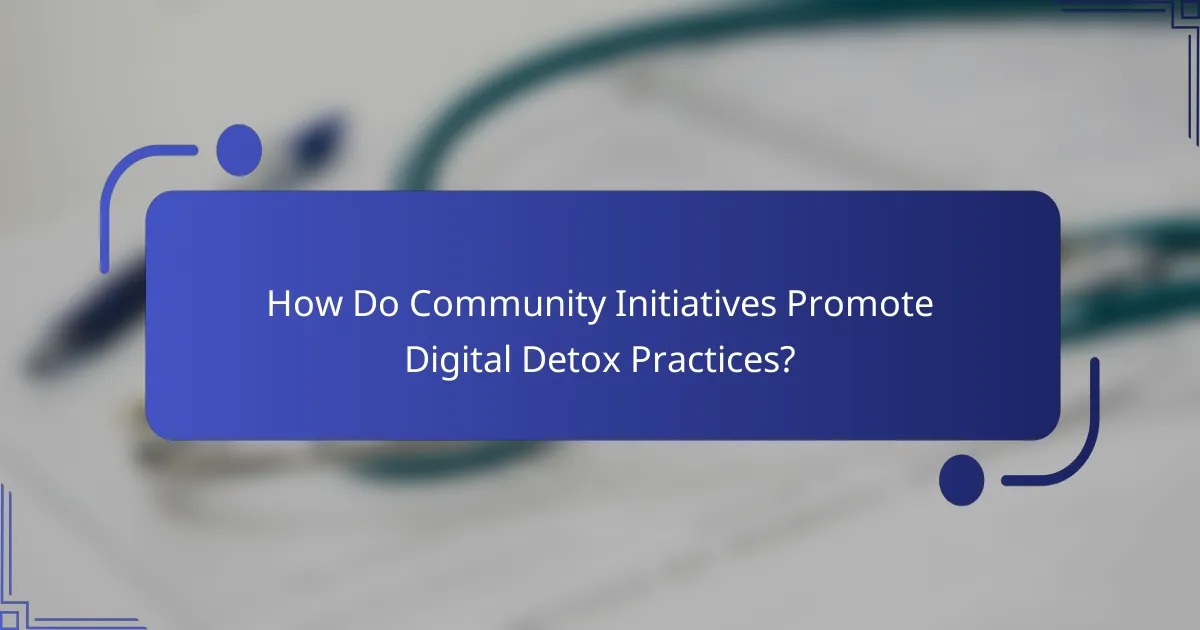
How Do Community Initiatives Promote Digital Detox Practices?
Community initiatives effectively promote digital detox practices by creating supportive environments that encourage reduced screen time. These initiatives often include organized events, workshops, and campaigns that raise awareness about the mental health benefits of disconnecting from digital devices.
For instance, local groups may host outdoor activities or mindfulness sessions that foster real-world connections. Research indicates that participants in community-led digital detox programs report lower levels of anxiety and improved focus.
Moreover, these initiatives often utilize social media to spread their message, paradoxically promoting the very detox they advocate. By leveraging community engagement, they create accountability and motivate individuals to adopt healthier digital habits.
Ultimately, community initiatives play a crucial role in facilitating digital detox practices, enhancing overall mental well-being.
What Role Do Local Organizations Play in Facilitating Digital Detox?
Local organizations play a crucial role in facilitating digital detox by creating supportive environments and programs. They offer workshops, community events, and resources that promote technology-free activities. These initiatives enhance mental well-being by encouraging social interactions and mindfulness practices. Moreover, local organizations can tailor their approaches to address unique community needs, fostering a sense of belonging and reducing digital dependency.
Which Events Encourage Community Engagement in Digital Wellbeing?
Events that encourage community engagement in digital wellbeing include workshops, online challenges, local meetups, and awareness campaigns. These initiatives foster connections and promote collective practices for digital detox, enhancing mental health. For example, community-led digital detox challenges can increase participation and accountability among members, leading to improved outcomes.
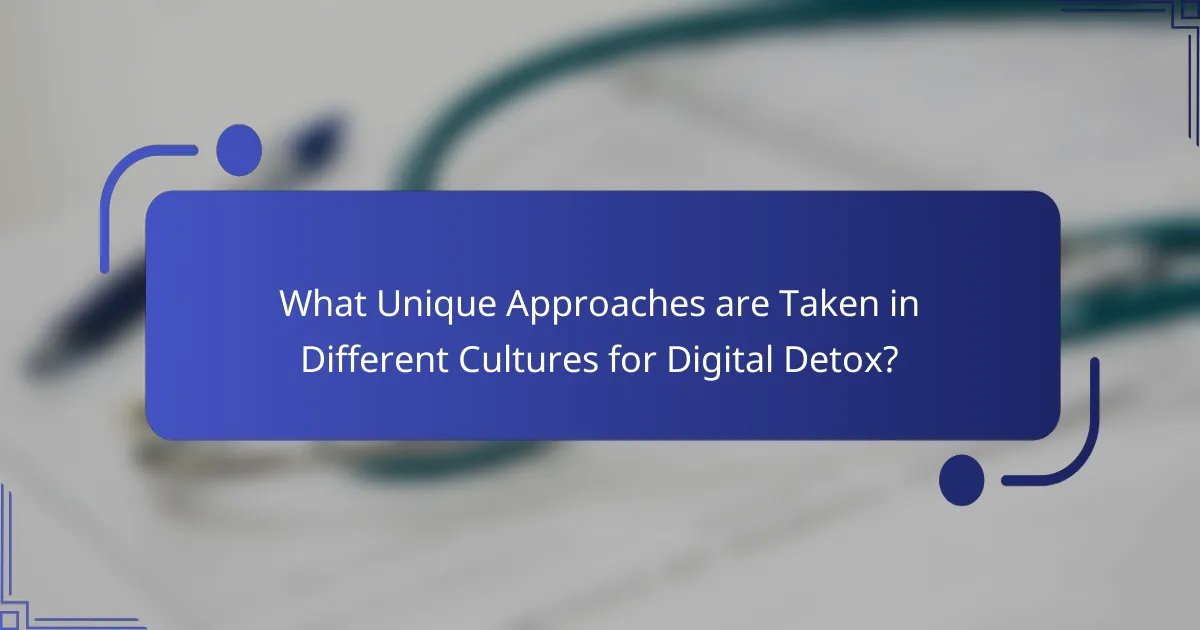
What Unique Approaches are Taken in Different Cultures for Digital Detox?
Different cultures adopt unique approaches for digital detox, emphasizing mental health and community well-being. For instance, Scandinavian countries promote nature immersion, encouraging outdoor activities to reduce screen time. In Japan, practices like Shinrin-yoku, or forest bathing, emphasize mindfulness and reconnection with nature. In contrast, some Indian communities integrate digital detox into spiritual retreats, focusing on meditation and yoga. These culturally distinct strategies highlight the global recognition of digital overload’s impact on mental health.
How Do Regional Attitudes Towards Technology Influence Detox Strategies?
Regional attitudes towards technology significantly shape detox strategies. Cultures that prioritize mental well-being often embrace structured digital detox programs. In contrast, regions with high technology reliance may resist these initiatives, viewing technology as essential. Community initiatives reflect these attitudes, promoting awareness and engagement in areas with supportive views. For example, urban centers frequently implement workshops that encourage balanced technology use, while rural areas may focus on nature-based retreats to facilitate detox. These strategies align with local values, enhancing their effectiveness in promoting mental health.
What Are Some Rare but Effective Digital Detox Retreats Worldwide?
Some rare but effective digital detox retreats worldwide include the Remote Year in various global locations, The Sanctuary Thailand, and Reboot Retreats in the United States. These retreats focus on disconnecting from technology to enhance mental well-being and foster community connections. Each offers unique activities such as mindfulness practices, nature immersion, and workshops on digital balance.
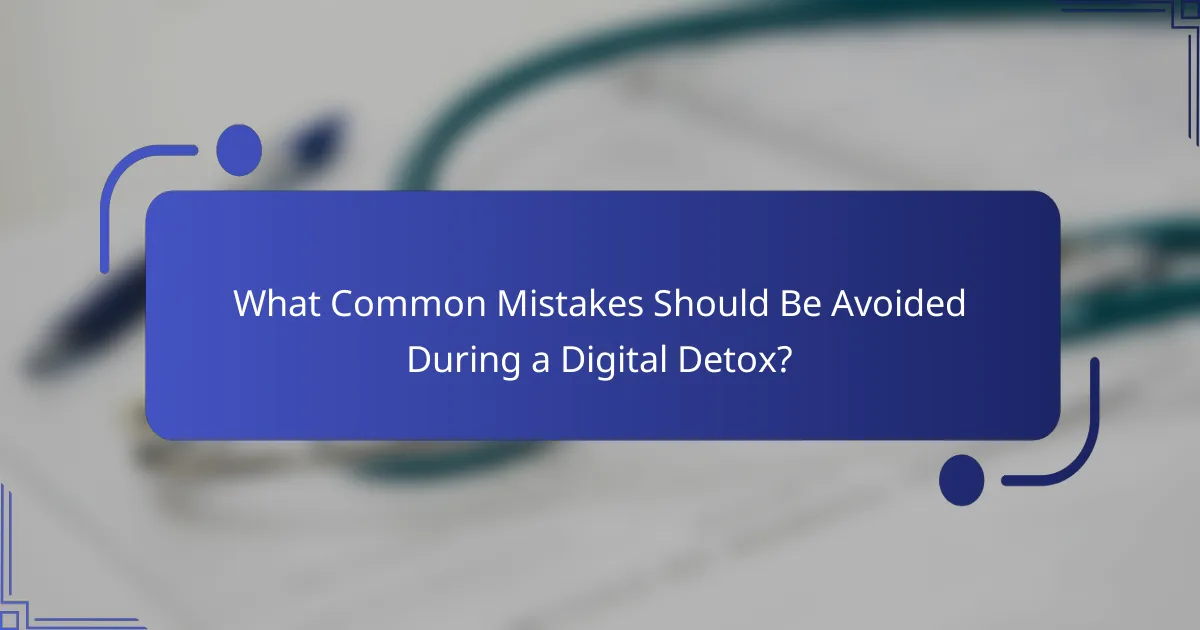
What Common Mistakes Should Be Avoided During a Digital Detox?
Avoiding common mistakes during a digital detox is crucial for its success. Key errors include setting unrealistic goals, neglecting to plan activities, and failing to communicate the detox intentions to others.
1. Setting unrealistic goals can lead to frustration and disengagement. Aim for manageable timeframes.
2. Neglecting to plan alternative activities may result in boredom, making it easier to revert to digital habits.
3. Failing to communicate intentions can lead to misunderstandings with family and friends, increasing pressure to return to devices.
4. Ignoring triggers that prompt device usage can undermine the detox effort; identify and address these triggers proactively.
5. Overlooking the need for gradual reintroduction of technology can cause overwhelm; establish a balanced approach post-detox.
How to Maintain Mental Wellbeing After Completing a Digital Detox?
To maintain mental wellbeing after a digital detox, focus on integrating mindful technology use and fostering real-world connections. Establish boundaries for device usage to prevent overwhelm. Engage in activities that promote mental clarity, such as meditation or journaling. Seek support from community initiatives that encourage offline interactions, enhancing social bonds and emotional resilience.
What Expert Tips Can Enhance the Digital Detox Experience?
To enhance the digital detox experience, consider these expert tips. Establish clear goals for your detox, such as reducing screen time or improving mindfulness. Create a structured schedule that includes tech-free activities, like reading or outdoor exercise. Engage with community initiatives that promote collective digital detox efforts, fostering accountability and support. Finally, reflect on your progress and adjust your strategies to maintain long-term benefits for mental health.
